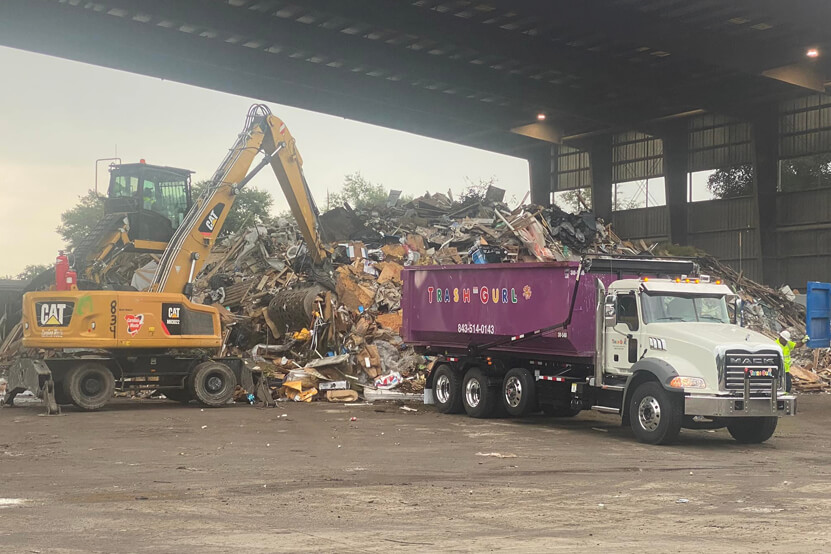Transporting hazardous materials isn’t just about putting barrels on a truck and driving off. It’s a highly regulated process that involves strict classification, labeling, and handling protocols to protect people, property, and the environment. At Trash Gurl, we don’t just handle waste—we do it safely, legally, and responsibly, including the transport of certain hazardous materials.
In this blog, we’ll explore the main types of hazardous materials, how they’re classified by federal law, and what that means for proper transportation. Whether you’re a contractor, event organizer, or business owner, understanding hazmat basics can help you avoid fines, accidents, and unnecessary risks.
What Is a Hazardous Material?
According to the U.S. Department of Transportation (DOT), a hazardous material is any substance or material that can pose a risk to health, safety, property, or the environment when transported. These materials are regulated under the Hazardous Materials Regulations (HMR), Title 49 of the Code of Federal Regulations (49 CFR Parts 100–185).
Hazmat comes in many forms, such as solids, liquids, gases, or combinations, and includes everything from industrial chemicals to paint thinners, batteries, and even some cleaning supplies. To safely and legally transport hazardous materials, the material must be classified into one of nine hazard classes, each with its own set of rules, labeling, and packaging requirements.
The 9 DOT Hazard Classes of Hazardous Materials
The DOT classifies hazardous materials into the following nine hazard classes. Each class covers specific types of materials and outlines the proper methods for their transportation.
Class 1: Explosives
These materials are capable of a sudden, violent release of pressure, gas, and heat when subjected to shock, heat, or flame.
Examples: Fireworks, ammunition, blasting caps, TNT
Subdivisions: 1.1 to 1.6 based on the type and sensitivity
Transport Notes: Highly regulated; often requires special routing and permits.
Class 2: Gases
This class includes any substance that is a gas at 68°F (20°C) and 14.7 psi. It’s divided into three categories:
- 2.1 Flammable gases: Propane, butane
- 2.2 Non-flammable, non-toxic gases: Nitrogen, carbon dioxide
- 2.3 Toxic gases: Chlorine, anhydrous ammonia
Gases are pressurized and can explode or leak when exposed to heat or damage, making proper containerization crucial.
Class 3: Flammable Liquids
These are liquids that ignite easily when exposed to an ignition source. They have a flash point of 140°F (60°C) or less.
Examples: Gasoline, acetone, ethanol, paint thinners
Transport Notes: Must be transported in approved drums or containers with clearly labeled flammable contents.
Class 4: Flammable Solids
Solids that can ignite through friction, heat, or moisture fall under this category.
- 4.1 Flammable solids: Matches, sulfur
- 4.2 Spontaneously combustible materials: Charcoal, oily rags
- 4.3 Dangerous when wet materials: Magnesium, sodium
These materials can be deceptively dangerous and require dry, cool transport conditions.
Class 5: Oxidizers and Organic Peroxides
These aren’t always combustible themselves, but they release oxygen or promote combustion.
- 5.1 Oxidizers: Hydrogen peroxide, bleach, nitrates
- 5.2 Organic peroxides: Used in resins, glues, and some plastics
They can make fires burn hotter and faster—proper separation during transport is essential.
Class 6: Toxic and Infectious Substances
Materials that can cause serious injury or death through inhalation, ingestion, or skin contact.
- 6.1 Toxic substances: Pesticides, cyanide, rat poison
- 6.2 Infectious substances: Medical waste, lab specimens
Trash Gurl collaborates with licensed partners to ensure that medical and biohazardous waste is handled in accordance with strict safety protocols.
Class 7: Radioactive Materials
This class includes materials that emit ionizing radiation, like uranium, medical isotopes, and nuclear waste.
Examples: Radiopharmaceuticals, smoke detector components
Transport Notes: Requires extensive licensing, placarding, and shielding.
Class 8: Corrosives
Corrosive materials degrade or destroy living tissue or metals on contact.
Examples: Sulfuric acid, battery acid, lye, caustic soda
Transport Notes: Must be stored in leak-proof containers with special liners; segregation from incompatible materials is critical.
Class 9: Miscellaneous Hazardous Materials
This “catch-all” class includes materials that pose hazards during transportation but don’t fit into Classes 1–8.
Examples: Lithium batteries, dry ice, asbestos, airbags
Transport Notes: Often overlooked but still highly regulated.
Why Proper Classification Matters
Misclassifying hazardous materials can lead to:
- DOT fines and legal penalties
- Increased accident risk
- Rejected shipments
- Environmental contamination
- Injury or death
Each hazmat class requires specific labeling, packaging, documentation (shipping papers), and sometimes specialized driver certifications (like a Hazmat endorsement on a CDL). At Trash Gurl, our team understands these regulations and handles all compliance requirements with care and precision.
How Trash Gurl Helps You Stay Safe and Compliant
We’re not just your roll-off dumpster and sanitation provider—we’re experienced in handling hazardous waste transportation and disposal in full compliance with federal and state laws.
Here’s how we support you:
- Identifying and classifying your waste properly
- Supplying the correct containers and labels
- Handling manifests, shipping papers, and reporting
- Coordinating transport with licensed hazmat carriers
- Providing reliable pickup and timely service
From commercial paint waste to industrial chemicals and contaminated debris, we work with businesses across the Lowcountry to provide safe, legal, and affordable hazmat transportation services.
Trust Trash Gurl for Safe, Reliable Hazmat Transport in Charleston
If you’re generating or disposing of potentially hazardous waste, don’t guess—get expert guidance. Understanding how hazardous materials are classified is essential for staying safe, avoiding costly mistakes, and protecting your team and community. Do you need help classifying or transporting hazardous waste in South Carolina? Trash Gurl is just a call away.
Contact us today to schedule a pickup or obtain a quote for hazardous material hauling and disposal.





